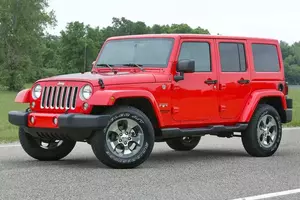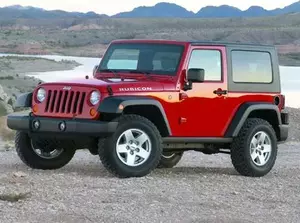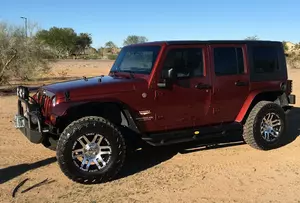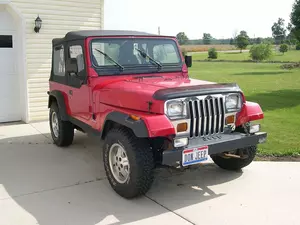
| Vehicle | Precise engine size | Difference from world average | Engine size to consumption ratio | Horsepower from 1 L | Engine size to 100 kg of weight |
|---|---|---|---|---|---|
| 3.6 V6 Rubicon |
3.61 L (3605 cc) |
53.7% bigger | - | 79 hp from 1 L | 190 cc to 100 kg |
| 2.2 Rubicon |
2.18 L (2184 cc) |
6.9% smaller | 73 cc to 1 mpg | 92 hp from 1 L | 99 cc to 100 kg |
| 2.2 Sahara |
2.18 L (2184 cc) |
6.9% smaller | 68 cc to 1 mpg | 92 hp from 1 L | 109 cc to 100 kg |
| 2.0 Sport |
2 L (1995 cc) |
15% smaller | - | 136 hp from 1 L | 100 cc to 100 kg |
| 2.0 Rubicon |
2 L (1995 cc) |
15% smaller | - | 136 hp from 1 L | 100 cc to 100 kg |
| 2.0 Sahara |
2 L (1995 cc) |
15% smaller | - | 136 hp from 1 L | 100 cc to 100 kg |
| Vehicle | 3.6 V6 Rubicon |
|---|---|
| Precise engine size | 3.61 L (3605 cc) |
| Difference from world average | 53.7 bigger |
| Engine size to consumption ratio | - |
| Horsepower from 1 L | 79 hp from 1 L |
| Engine size to 100 kg of weight | 190 cc to 100 kg |
| Vehicle | 2.2 Rubicon |
| Precise engine size | 2.18 L (2184 cc) |
| Difference from world average | 6.9 smaller |
| Engine size to consumption ratio | 73 cc to 1 mpg |
| Horsepower from 1 L | 92 hp from 1 L |
| Engine size to 100 kg of weight | 99 cc to 100 kg |
| Vehicle | 2.2 Sahara |
| Precise engine size | 2.18 L (2184 cc) |
| Difference from world average | 6.9 smaller |
| Engine size to consumption ratio | 68 cc to 1 mpg |
| Horsepower from 1 L | 92 hp from 1 L |
| Engine size to 100 kg of weight | 109 cc to 100 kg |
| Vehicle | 2.0 Sport |
| Precise engine size | 2 L (1995 cc) |
| Difference from world average | 15 smaller |
| Engine size to consumption ratio | - |
| Horsepower from 1 L | 136 hp from 1 L |
| Engine size to 100 kg of weight | 100 cc to 100 kg |
| Vehicle | 2.0 Rubicon |
| Precise engine size | 2 L (1995 cc) |
| Difference from world average | 15 smaller |
| Engine size to consumption ratio | - |
| Horsepower from 1 L | 136 hp from 1 L |
| Engine size to 100 kg of weight | 100 cc to 100 kg |
| Vehicle | 2.0 Sahara |
| Precise engine size | 2 L (1995 cc) |
| Difference from world average | 15 smaller |
| Engine size to consumption ratio | - |
| Horsepower from 1 L | 136 hp from 1 L |
| Engine size to 100 kg of weight | 100 cc to 100 kg |

| Vehicle | Precise engine size | Difference from world average | Engine size to consumption ratio | Horsepower from 1 L | Engine size to 100 kg of weight |
|---|---|---|---|---|---|
| 3.8i V6 Sport |
3.78 L (3778 cc) |
61% bigger | 172 cc to 1 mpg | 52 hp from 1 L | 210 cc to 100 kg |
| 3.8i V6 Sahara |
3.78 L (3778 cc) |
61% bigger | 210 cc to 1 mpg | 53 hp from 1 L | 210 cc to 100 kg |
| 2.8 CRDi Sport |
2.78 L (2776 cc) |
18.3% bigger | 84 cc to 1 mpg | 71 hp from 1 L | 146 cc to 100 kg |
| 3.6i V6 12V Sahara |
3.6 L (3604 cc) |
53.6% bigger | 172 cc to 1 mpg | 78 hp from 1 L | 200 cc to 100 kg |
| 2.8 CRDi Sahara |
2.78 L (2776 cc) |
18.3% bigger | 96 cc to 1 mpg | 71 hp from 1 L | 146 cc to 100 kg |
| 3.8i V6 Rubicon |
3.78 L (3778 cc) |
61% bigger | 189 cc to 1 mpg | 52 hp from 1 L | 222 cc to 100 kg |
| Vehicle | 3.8i V6 Sport |
|---|---|
| Precise engine size | 3.78 L (3778 cc) |
| Difference from world average | 61 bigger |
| Engine size to consumption ratio | 172 cc to 1 mpg |
| Horsepower from 1 L | 52 hp from 1 L |
| Engine size to 100 kg of weight | 210 cc to 100 kg |
| Vehicle | 3.8i V6 Sahara |
| Precise engine size | 3.78 L (3778 cc) |
| Difference from world average | 61 bigger |
| Engine size to consumption ratio | 210 cc to 1 mpg |
| Horsepower from 1 L | 53 hp from 1 L |
| Engine size to 100 kg of weight | 210 cc to 100 kg |
| Vehicle | 2.8 CRDi Sport |
| Precise engine size | 2.78 L (2776 cc) |
| Difference from world average | 18.3 bigger |
| Engine size to consumption ratio | 84 cc to 1 mpg |
| Horsepower from 1 L | 71 hp from 1 L |
| Engine size to 100 kg of weight | 146 cc to 100 kg |
| Vehicle | 3.6i V6 12V Sahara |
| Precise engine size | 3.6 L (3604 cc) |
| Difference from world average | 53.6 bigger |
| Engine size to consumption ratio | 172 cc to 1 mpg |
| Horsepower from 1 L | 78 hp from 1 L |
| Engine size to 100 kg of weight | 200 cc to 100 kg |
| Vehicle | 2.8 CRDi Sahara |
| Precise engine size | 2.78 L (2776 cc) |
| Difference from world average | 18.3 bigger |
| Engine size to consumption ratio | 96 cc to 1 mpg |
| Horsepower from 1 L | 71 hp from 1 L |
| Engine size to 100 kg of weight | 146 cc to 100 kg |
| Vehicle | 3.8i V6 Rubicon |
| Precise engine size | 3.78 L (3778 cc) |
| Difference from world average | 61 bigger |
| Engine size to consumption ratio | 189 cc to 1 mpg |
| Horsepower from 1 L | 52 hp from 1 L |
| Engine size to 100 kg of weight | 222 cc to 100 kg |

| Vehicle | Precise engine size | Difference from world average | Engine size to consumption ratio | Horsepower from 1 L | Engine size to 100 kg of weight |
|---|---|---|---|---|---|
| 3.8i V6 12V Sahara |
3.78 L (3778 cc) |
61% bigger | 222 cc to 1 mpg | 53 hp from 1 L | 189 cc to 100 kg |
| 3.6i V6 12V Sport |
3.6 L (3604 cc) |
53.6% bigger | 180 cc to 1 mpg | 78 hp from 1 L | 190 cc to 100 kg |
| 2.8 CRDi |
2.78 L (2778 cc) |
18.4% bigger | 116 cc to 1 mpg | 63 hp from 1 L | 139 cc to 100 kg |
| 3.8i V6 12V |
3.78 L (3778 cc) |
61% bigger | 189 cc to 1 mpg | 52 hp from 1 L | 199 cc to 100 kg |
| Vehicle | 3.8i V6 12V Sahara |
|---|---|
| Precise engine size | 3.78 L (3778 cc) |
| Difference from world average | 61 bigger |
| Engine size to consumption ratio | 222 cc to 1 mpg |
| Horsepower from 1 L | 53 hp from 1 L |
| Engine size to 100 kg of weight | 189 cc to 100 kg |
| Vehicle | 3.6i V6 12V Sport |
| Precise engine size | 3.6 L (3604 cc) |
| Difference from world average | 53.6 bigger |
| Engine size to consumption ratio | 180 cc to 1 mpg |
| Horsepower from 1 L | 78 hp from 1 L |
| Engine size to 100 kg of weight | 190 cc to 100 kg |
| Vehicle | 2.8 CRDi |
| Precise engine size | 2.78 L (2778 cc) |
| Difference from world average | 18.4 bigger |
| Engine size to consumption ratio | 116 cc to 1 mpg |
| Horsepower from 1 L | 63 hp from 1 L |
| Engine size to 100 kg of weight | 139 cc to 100 kg |
| Vehicle | 3.8i V6 12V |
| Precise engine size | 3.78 L (3778 cc) |
| Difference from world average | 61 bigger |
| Engine size to consumption ratio | 189 cc to 1 mpg |
| Horsepower from 1 L | 52 hp from 1 L |
| Engine size to 100 kg of weight | 199 cc to 100 kg |

| Vehicle | Precise engine size | Difference from world average | Engine size to consumption ratio | Horsepower from 1 L | Engine size to 100 kg of weight |
|---|---|---|---|---|---|
| 2.4 i 16V |
2.43 L (2429 cc) |
3.5% bigger | 106 cc to 1 mpg | 60 hp from 1 L | 152 cc to 100 kg |
| 4.0 i |
3.96 L (3956 cc) |
68.6% bigger | - | 48 hp from 1 L | 264 cc to 100 kg |
| 4.0 i Rubicon |
3.96 L (3956 cc) |
68.6% bigger | - | 49 hp from 1 L | 233 cc to 100 kg |
| 2.5 i |
2.46 L (2464 cc) |
5% bigger | - | 48 hp from 1 L | 164 cc to 100 kg |
| 2.5 i Soft Top |
2.46 L (2464 cc) |
5% bigger | - | 48 hp from 1 L | 176 cc to 100 kg |
| Vehicle | 2.4 i 16V |
|---|---|
| Precise engine size | 2.43 L (2429 cc) |
| Difference from world average | 3.5 bigger |
| Engine size to consumption ratio | 106 cc to 1 mpg |
| Horsepower from 1 L | 60 hp from 1 L |
| Engine size to 100 kg of weight | 152 cc to 100 kg |
| Vehicle | 4.0 i |
| Precise engine size | 3.96 L (3956 cc) |
| Difference from world average | 68.6 bigger |
| Engine size to consumption ratio | - |
| Horsepower from 1 L | 48 hp from 1 L |
| Engine size to 100 kg of weight | 264 cc to 100 kg |
| Vehicle | 4.0 i Rubicon |
| Precise engine size | 3.96 L (3956 cc) |
| Difference from world average | 68.6 bigger |
| Engine size to consumption ratio | - |
| Horsepower from 1 L | 49 hp from 1 L |
| Engine size to 100 kg of weight | 233 cc to 100 kg |
| Vehicle | 2.5 i |
| Precise engine size | 2.46 L (2464 cc) |
| Difference from world average | 5 bigger |
| Engine size to consumption ratio | - |
| Horsepower from 1 L | 48 hp from 1 L |
| Engine size to 100 kg of weight | 164 cc to 100 kg |
| Vehicle | 2.5 i Soft Top |
| Precise engine size | 2.46 L (2464 cc) |
| Difference from world average | 5 bigger |
| Engine size to consumption ratio | - |
| Horsepower from 1 L | 48 hp from 1 L |
| Engine size to 100 kg of weight | 176 cc to 100 kg |

| Vehicle | Precise engine size | Difference from world average | Engine size to consumption ratio | Horsepower from 1 L | Engine size to 100 kg of weight |
|---|---|---|---|---|---|
| 4.0 i |
3.96 L (3964 cc) |
69% bigger | 248 cc to 1 mpg | 46 hp from 1 L | 248 cc to 100 kg |
| 2.5 i |
2.46 L (2464 cc) |
5% bigger | 145 cc to 1 mpg | 49 hp from 1 L | 164 cc to 100 kg |
| Vehicle | 4.0 i |
|---|---|
| Precise engine size | 3.96 L (3964 cc) |
| Difference from world average | 69 bigger |
| Engine size to consumption ratio | 248 cc to 1 mpg |
| Horsepower from 1 L | 46 hp from 1 L |
| Engine size to 100 kg of weight | 248 cc to 100 kg |
| Vehicle | 2.5 i |
| Precise engine size | 2.46 L (2464 cc) |
| Difference from world average | 5 bigger |
| Engine size to consumption ratio | 145 cc to 1 mpg |
| Horsepower from 1 L | 49 hp from 1 L |
| Engine size to 100 kg of weight | 164 cc to 100 kg |